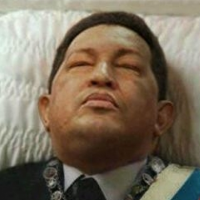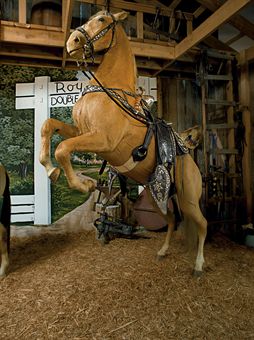8 American Humans and Animals who were Preserved after Death
 Hugo Chávez
Hugo Chávez
Many people might find it weird that Venezuelans embalmed Hugo Chávez and put him on public display. However Americans have not been immune from preserving the bodies of the deceased. Here are eight examples: two criminals, a hobo, a baseball player, two horses, an elephant and a gorilla.
1. Elmer McCurdy
Elmer McCurdy was a not particularly competent bank and train robber who was killed during a shootout with a posse in Oklahoma on October 7, 1911. The posse had wanted to take him alive in order to collect a reward for his arrest, and his last words were said to be, “You’ll never take me alive.” They didn’t, but that was not the end of the story of his body. No one claimed McCurdy’s body, so the local undertaker embalmed the corpse and charged visitors a nickel to view it. Five years later, a traveling carnival gained position of McCurdy and, for the next six decades, he was sold on to a series of carnivals, haunted houses and wax museums. Eventually he ended up hanging from a noose at an amusement park in Long Beach, California, although the condition of his corpse had deteriorated to such an extent that visitors thought he was a mannequin. In December 1976, a crew preparing to shoot an episode of the TV series “The Six Million Man” moved what they thought was a wax dummy. When one of its arms fell off, they discovered that it was a real corpse, which turned out to be Elmer McCurdy. He was finally buried in Guthrie, Oklahoma, on April 22, 1977.

2. Joseph Paul Jernigan
In 1993, Joseph Paul Jernigan was executed in Texas for the 1981 murder of a 75-year-old man during a burglary. Because Jernigan donated his body to science, his body was frozen and shipped to the University of Colorado, where it was “sliced” into 1,871 cross-sections. Two years later, a 59-year-old Maryland woman was similarly sliced, but into 5,000 segments. These two became the subjects of the Visible Human Project, the first computerized library of human anatomy, to be made available to medical researchers around the world.

3. Anderson McCrew
In 1913, a one-legged African-American hobo died after falling off a moving freight train in Marlin, Texas. Anderson (also known as Andrew) McCrew was dead, but he did not rest in peace for 60 years. The morning after his death, he was taken to a funeral parlor and embalmed. In a case similar to that of Elmer McCurdy, when no one appeared to claim the body, a traveling carnival purchased it and displayed McCrew as “The Amazing Petrified Man—The Eighth Wonder of the World.” When the troupe disbanded 55 years later, McCrew remained in storage until a Dallas widow, Elgie Pace, discovered him in 1969. She wanted to give him a decent burial because, as she said to her sister, “He’s a human being. You just can’t throw a body in a ditch.” However, she was unable to afford the cost of burial, so she nicknamed him “Sam” and kept him in the basement. Eventually, local black undertakers Frank and Judy Lott volunteered to give McCrew a funeral. Anderson McCrew was finally laid to rest at Dallas’ Lincoln Memorial Cemetery on June 2, 1973. Th following year, folksinger Don McLean wrote a song, “The Legend of Andrew McCrew,” which inspired a radio listener to purchase a gravestone for McCrew, The stone reads: “Andrew McCrew, ‘The Mummified Man,’ Born 1867/Died 1913/Buried 1973.”
.jpg)
4. Ted Williams
One of the most famous baseball players of all-time, Ted Williams is the only person in the last 83 years to bat .400 for a single season (.406 in 1941). After he died at age 83 in 2002, he was taken to the Alcor Life Extension Foundation’s facility in Scottsdale, Arizona, and cryonically frozen. The decision was challenged by Williams’s oldest daughter, Bobby Jo, since his will stated that he wanted to be cremated and have his ashes scattered off the Florida Keys. Williams’ son John Henry produced a note in which he, Ted, and Ted’s daughter Claudia entered into a pact to freeze themselves after death. The handwritten pact, signed by all three, read, “JHW, Claudia and Dad all agree to be put in Bio-stasis after we die. This is what we want, to be able to be together in the future, even if it is only a chance.” The suit was settled in December of 2002, and Ted Williams will remain indefinitely in one of Alcor’s liquid nitrogen-filled cryogenic tanks.

5. Comanche
Comanche, a U.S. Army horse who survived the June 1876 Battle of the Little Big Horn (a.k.a. Custer’s Last Stand), died a national hero on November 7, 1891, and it was decided to preserve and mount him. A University of Kansas naturalist, Professor Lewis Lindsay Dyche, did the job. Comanche’s insides were given a military funeral. His outsides were preserved, shown at the Columbian Exposition in Chicago in 1893, and then placed in the University of Kansas Museum of Natural History in Lawrence. In 1947, Gen. Jonathan Wainwright tried to get Comanche back to be a U.S. Army exhibit in Fort Riley, but failed. In 1950, to save his hide from expanding and contracting, Comanche was placed in an airtight glass case with humidity control, and set against an artificial “sunbaked” setting of soil and grass. The museum dismantled the exhibit in 2005, restored the mount and moved Comanche to the fourth floor, where he can now be seen.
.jpg)
6. Trigger
The world’s most famous animal actor, Trigger costarred with Roy Rogers in 88 motion pictures and 100 television shows. An unusually intelligent horse, Trigger was able to untie knots with his teeth and count to 20. Upon his death in 1965 at the age of 32, Trigger was stuffed and mounted and put on display at the Roy Rogers Museum in Victorville, Calif., as was Dale Evans’ horse, Buttermilk, and their German shepherd dog, Bullet. The museum and its contents were moved to Branson, Missouri, in 2003. The museum closed down in 2009, and in July 2010 Trigger’s hide was purchased (along with Bullet) at auction by RFD-TV of Nebraska for $266,500.

7. Jumbo
Jumbo was born in Sudan in about 1859, captured by a local elephant hunter and sold to an Italian animal dealer, eventually ending up at the Jardin des Plantes in Paris and then, in 1865, at the London Zoological Gardens. There he lived in relative peace until American circus entrepreneur Phineas T. Barnum, attracted by Jumbo’s large size (10¾ feet tall and weighing 7 tons), purchased him in 1882. Barnum first displayed Jumbo at Madison Square Garden in New York City and then sent him around North America as part of his travelling circus for the next three years. On September 15, 1885, Jumbo was hit by a freight train in St. Thomas, Ontario, in Canada and killed. Barnum, who lost one of his biggest draws, had Jumbo’s carcass stuffed and continued to display him for a couple years. Then he sent Jumbo’s skeleton to the American Museum of Natural History in New York and put his stuffed hide on permanent exhibit in Barnum Hall, Tufts University, Medford, Massachusetts. In April, 1975, a fire swept Barnum Hall and destroyed Jumbo‘s remains.
.gif)
8. Bushman
Like Jumbo, Bushman was born in Africa, shipped to the United States and attracted attention because of his large size. In Bushman’s case, he was born in Cameroon in 1928 and grew to be 6 feet 2 inches tall and weigh 547 pounds. He lived in Chicago’s Lincoln Park Zoo over a period of 20 years from 1930 through 1950. After he died of a heart attack, he was stuffed and mounted. Bushman continues to impress visitors at Chicago’s Field Museum of Natural History, where he glares from a sealed glass case.

-David Wallechinsky
- Top Stories
- Unusual News
- Where is the Money Going?
- Controversies
- U.S. and the World
- Appointments and Resignations
- Latest News
- Musk and Trump Fire Members of Congress
- Trump Calls for Violent Street Demonstrations Against Himself
- Trump Changes Name of Republican Party
- The 2024 Election By the Numbers
- Bashar al-Assad—The Fall of a Rabid AntiSemite






Comments